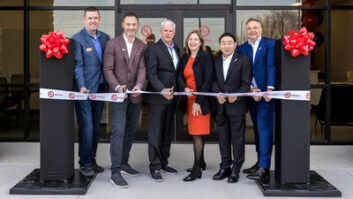MIKE LINTON: At Best Buy, we are seeing a huge move to the clicks-and-mortar model. Forty percent of our shoppers at some time of the year were on bestbuy.com. And they’re using it to do a whole bunch of research before they come into the store. We always believed in the model, but the consumers have made the move faster than we anticipated.
TWICE:One of Best Buy’s holiday spots actually encouraged online research followed by an in-store purchase. Is that your preferred shopping approach?
LINTON: We want the consumer to have a choice. How they buy is up to them. We will make it as easy for them as possible, and we want them to have a choice to use the channels together or separately. What we are finding is they have a tendency to use them together.
We’re also finding that the top five reasons consumers are coming to the site are information-based, for technological help, and they use the site a lot to help figure it out. And since we have the site in the store — and we actually use our store sites as training devices — we are seeing a lot of interplay between the site and the store. And our consumers, frankly, look like they expect it.
So we are pleased that the model we put in place three years ago is working, but we’re definitely seeing that the power of the two channels together benefits both channels immensely.
TWICE:Sears chairman Alan Lacy said consumers are mostly using the appliance site for research. Is that true for electronics, too?
RAY BROWN: Yes. You know, at the end of the day I just don’t want to kick the tires. They will do the feeds and speeds type of research, and then somebody will want to come in eventually to look at the picture and they want to hear it.
Every single month the number of folks that visit our site and then come in and buy from us continues to go up in that correlation. We’re aligned to the fact that we think it is critical to have that air-plate between the two.
Whether we sell them on the site or sell them in the mortar environment doesn’t really matter to us. But in CE specifically, and especially in television, while we do some HD over the site, they still want to see the picture.
So they do all the research, walk in specifically with a printout, saying, ‘All right, for the value I want to see this particular brand,’ walk over and look at the picture — ooh and ah — and walk out with it.
TWICE:Circuit City and Amazon.com have taken the bricks-and-clicks approach to a new level.
RICK SOUDER: Right. We were just getting started as we moved into the fall and we remain optimistic about it. I have seen some good movement in traffic across the sites as we’ve supplemented the products that were already available on Amazon. I am seeing Amazon customers take advantage of the ability to pick the product up in one of the stores that happens to be closest to them.
So, I think it is a good symbiosis. And we’ll see where it goes.
TWICE:Don’t you risk blurring your online brand identities with this arrangement?
FRANK SADOWSKI: If Amazon.com was not an established brand, there would be that kind of risk. But Amazon.com is one of the most recognizable brands in the world. Not just in e-commerce and not just in retail, but in the world. I think it was number 67 last year, ahead of some pretty famous companies like Fed-Ex.
One of the keys to the success of a partnership like we have with Circuit City is that both companies are already fully mature brands. And just as Circuit City or Best Buy are known primarily for brick-and-mortar, then it is not surprising that a bricks-and-clicks model works very well — that a lot of people do want to do research online and then go into the store. I think that as the model matures, that’s what you are going to see.
Conversely, Amazon.com is also a place where people go to shop. At the end of the third quarter we had almost 30 million customers. Over 50 percent of everyone who has ever shopped online is a customer of Amazon.com.
And so I don’t think the partnership dilutes Circuit’s brand, and I don’t think it does anything negative for Amazon’s brand either. It does show our platform technology and it shows the consumer that Amazon is truly a place to find and purchase anything you want online.
Down the stretch, our online holiday shopping season doesn’t have to end earlier than brick-and-mortar’s anymore. The customers now have the option, right down to the end, to see if an item is in stock, plug in their ZIP codes, find a location, do the purchase on Amazon.com’s platform and go and pick the product up immediately at Circuit City. That’s very strong.
And the ability to show a wider assortment of products and brands pleases the customer, and quite candidly it causes them to buy more online too.
So we are just getting started and we’ve got to feel our way along and learn how this thing will work best for both of the companies and particularly how it is going to work best for the consumer. But so far the customer seems to really embrace it. There doesn’t seem to be any confusion about what we are doing in the mind of the customer. And once again I think that’s because of the strength of the brands.
SOUDER: We’re trying to address whatever the customer wants to do and however they would like to interrelate with your business. I think we have all had to adapt to that over the last several years.
TWICE:Circuit is authorized to sell some products that Amazon isn’t. How have the vendors handled that issue?
SOUDER: You’d have to ask the suppliers. We all work closely with our suppliers, we try not to surprise them. They have been supportive in the different efforts as we initially went online and as we entered this relationship with Amazon I would expect that to continue.













